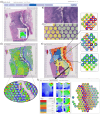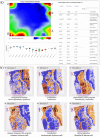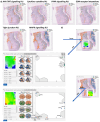A Spatial Transcriptomics Browser for Discovering Gene Expression Landscapes across Microscopic Tissue Sections
- PMID: 38785552
- PMCID: PMC11119626
- DOI: 10.3390/cimb46050284
A Spatial Transcriptomics Browser for Discovering Gene Expression Landscapes across Microscopic Tissue Sections
Abstract
A crucial feature of life is its spatial organization and compartmentalization on the molecular, cellular, and tissue levels. Spatial transcriptomics (ST) technology has opened a new chapter of the sequencing revolution, emerging rapidly with transformative effects across biology. This technique produces extensive and complex sequencing data, raising the need for computational methods for their comprehensive analysis and interpretation. We developed the ST browser web tool for the interactive discovery of ST images, focusing on different functional aspects such as single gene expression, the expression of functional gene sets, as well as the inspection of the spatial patterns of cell-cell interactions. As a unique feature, our tool applies self-organizing map (SOM) machine learning to the ST data. Our SOM data portrayal method generates individual gene expression landscapes for each spot in the ST image, enabling its downstream analysis with high resolution. The performance of the spatial browser is demonstrated by disentangling the intra-tumoral heterogeneity of melanoma and the microarchitecture of the mouse brain. The integration of machine-learning-based SOM portrayal into an interactive ST analysis environment opens novel perspectives for the comprehensive knowledge mining of the organization and interactions of cellular ecosystems.
Keywords: 10x Visium technology; intra-tumoral heterogeneity microanatomy; melanoma; molecular biology; mouse brain; receptor–ligand interactions; self-organizing map (SOM) machine learning; spatial gene set analysis.
Conflict of interest statement
The authors declare no conflicts of interest.
Figures







Similar articles
-
Computational solutions for spatial transcriptomics.Comput Struct Biotechnol J. 2022 Sep 1;20:4870-4884. doi: 10.1016/j.csbj.2022.08.043. eCollection 2022. Comput Struct Biotechnol J. 2022. PMID: 36147664 Free PMC article. Review.
-
SpatialView: an interactive web application for visualization of multiple samples in spatial transcriptomics experiments.Bioinformatics. 2024 Mar 4;40(3):btae117. doi: 10.1093/bioinformatics/btae117. Bioinformatics. 2024. PMID: 38444087 Free PMC article.
-
Scoping Review: Methods and Applications of Spatial Transcriptomics in Tumor Research.Cancers (Basel). 2024 Sep 6;16(17):3100. doi: 10.3390/cancers16173100. Cancers (Basel). 2024. PMID: 39272958 Free PMC article.
-
Spatial transcriptomics reveal basal sex differences in supraoptic nucleus gene expression of adult rats related to cell signaling and ribosomal pathways.Biol Sex Differ. 2023 Oct 19;14(1):71. doi: 10.1186/s13293-023-00554-3. Biol Sex Differ. 2023. PMID: 37858270 Free PMC article.
-
oposSOM-Browser: an interactive tool to explore omics data landscapes in health science.BMC Bioinformatics. 2020 Oct 19;21(1):465. doi: 10.1186/s12859-020-03806-w. BMC Bioinformatics. 2020. PMID: 33076824 Free PMC article.
Cited by
-
Topology-aware pathway analysis of spatial transcriptomics.PeerJ. 2025 Aug 14;13:e19729. doi: 10.7717/peerj.19729. eCollection 2025. PeerJ. 2025. PMID: 40827204 Free PMC article.
References
-
- Sottoriva A., Spiteri I., Piccirillo S.G.M., Touloumis A., Collins V.P., Marioni J.C., Curtis C., Watts C., Tavaré S. Intratumor heterogeneity in human glioblastoma reflects cancer evolutionary dynamics. Proc. Natl. Acad. Sci. USA. 2013;110:4009–4014. doi: 10.1073/pnas.1219747110. - DOI - PMC - PubMed
Grants and funding
LinkOut - more resources
Full Text Sources
Research Materials

